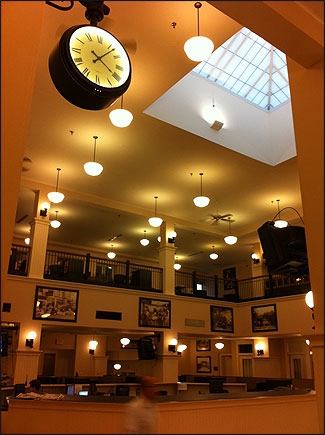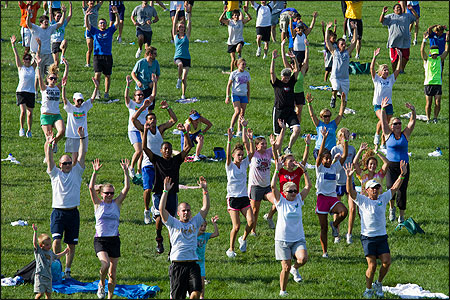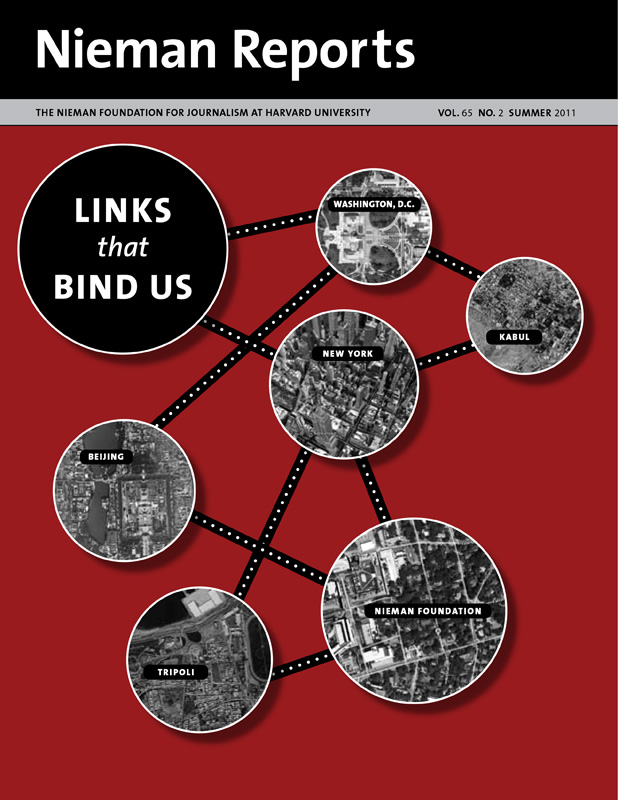
The newsroom of the community health website WellCommons.com is located in The World Company’s offices in Lawrence, Kansas. Photo by Jane Stevens.
In April 2010, The World Company, a family-owned news organization in Lawrence, Kansas (population 88,000), launched WellCommons, created to be the community's health site. While it's difficult to determine the "first" in anything digital, WellCommons is certainly among the pioneers in marrying journalism and social media—and making it work for reporters and citizens alike.
Here are a few of its elements heading us in this direction:
Community Engagement: WellCommons provides a look at what journalism can be when integrated with social media. Using a content management system (CMS) that we developed, our site eliminates the barriers that have separated journalists from community members. At the same time, we preserve the goal of being a trusted source of information and news within the community and a safe place for people to share what they know and think.
Niche Journalism: In addition to its main site for the Lawrence Journal-World, LJWorld.com, The World Company already has two niche websites—KUSports.com and lawrence.com, an entertainment site—developed in the late 1990's and mid-2000's, respectively. WellCommons is the first in the company's planned series of social journalism niche sites that it hopes will comprise a Northeast Kansas news network.
New Advertising Model: WellCommons relies on display ads and sponsorship for its revenue. It also gives local businesses that provide health products and services access to the same content-generating and community-building tools as anyone else—and this gives them direct access to and conversations with community members. But businesses—unlike residents and community service organizations—must pay to participate. We are also working on melding social media and display ads; right now, ads are still displayed in the we-talk-you-listen mode. At this point, there's no visual difference between the group pages for businesses and those belonging to nonprofits. We did this for two reasons: The community is small enough that people know which organization is a nonprofit and which is a business, and each group page provides a description of the organization's activities. With the group structure, we recognize that every organization has a vested interest in the information it is providing, whether it is a business or a nonprofit.

Last summer about 1,000 people joined what organizers billed as the “World’s Largest Community Workout” in Lawrence, Kansas—with WellCommons as a booster. Photo by Kevin Anderson.
Our Beginnings
The roots of WellCommons extend to when I was a Reynolds Fellow at the University of Missouri School of Journalism in 2008-09 and I created HealthCommons. That spring a group of students and I developed a prototype. Here are some of the things we set out to do:
- Map the community to identify major players that influence change by promoting or stopping it.
- Use community data to identify major issues that a typical newsroom reported on once or twice and then didn't revisit for months or years.
- Report on those underreported topics.
- Provide context and continuity for our stories by posting information about our reporting on them.
- Let the community know how these stories affected what happened after publication.
Most of all, we wanted to weave content from the local health community into the site's news stream. However, the Ellington CMS that The World Company developed in 2004 and graciously gave us to use was very helpful in developing a conceptual product, but it didn't have all the tools we needed to actually marry social media and journalism.
So when we covered young women's health, we tried to set up a Facebook page, but back then Facebook couldn't do what we had in mind either. Since then Facebook has made significant progress in this direction but it still isn't totally there. Yet I am confident that Facebook, WordPress or Google will soon master this approach. An encouraging sign is that earlier this year Paul Adams, who did a presentation he calls "The Real Life Social Network" and is writing a book about social circles, left Google to go to work for Facebook.
By that semester's end, HealthCommons had withstood its test as a concept. What it needed was a booster—with funding—to transform it into something real. The World Company surfaced as its champion. In June 2009 the company hired me as its director of media strategies. This meant that I'd supervise its websites while leading the development of a local health site integrating community and journalism.
Working with a crackerjack development team and turning concept into AUTHOR'S NOTE
Members of our development team included Christian Metts, Ben Turner, Ben Spaulding, Eric Holscher, and Charlie Leifer as well as Jonathan Kealing, assistant director of media strategies.reality is relatively easy. Needed are time and focus. Our team got to work in December 2009 and three months later we launched a private beta version of our CMS system; our public beta went live in April 2010. "We weren't really inventing anything new," says our team manager, Christian Metts. "We were just catching up with the rest of the Internet."
Maybe so, but when it comes to the journalism, this was something new. We were inventing a digital town square, and moving beyond citizen journalism, content farming, and crowdsourcing. A new mindset emerged as the site's gates swung open to community involvement. Now, community members are part of what we do every step along the way—and we are progressing together.
Getting Started
Six months before we launched WellCommons, about 30 community members—some of whom are doctors, others health advocates, some people with no health insurance, others who are locavores—began meeting regularly with our development team to talk about the website. Part trust building, part content harvesting, our community gatherings still take place every few months.
Some of those who use the site refer to WellCommons as "Facebook for the local health community." Text and video, photographs and graphics are posted directly to the site—by anyone, in much the same way people share things of interest with their friends on Facebook. Community posts are integrated with what the site's journalists produce. On the site, participants can follow and message each other and repost items; it's easy to send posts to Facebook and Twitter.
Similar to how Facebook works, individuals and organizations start groups. Our site's action tends to bubble up from these group pages since content put there automatically aggregates on the WellCommons home page. More than 100 groups are at various stages of development; we work with them to set goals and help them grow their communities and achieve their goals. Among their goals are enlisting more local restaurants to put local foods on their menus, reducing domestic violence, developing school gardens, engaging more people in exercise events, and building more bike trails.
Working in this way requires time and commitment that journalists normally don't devote to such tasks. But doing this pays off for WellCommons as community members repay us in what they contribute to the site. From the start, our goal was to have about 10 new posts a day, with half coming from the community. Right now we hit that number—or exceed it—two days a week.
Building Trust
The site's information architecture helps people to assess the reliability of information. Real names are associated with all of the posts to the site. (A person can contribute three comments before a real name is required.) All of the site's groups, whether launched by a reporter, an individual, a business, a nonprofit, or an institution, function with this same rule—real names go along with informational postings, stories and comments. This means that information is judged on the basis of the person who posted it and the group from which it comes.
We have a staff reporter who monitors the site full time; if that reporter can't be doing this for some reason, another staff member will. This reporter also answers questions from community members and responds to their posts and comments. Abusive comments are deleted. When community members want us to look into an issue, we will.
Slow News—Aimed at Solutions
We take a community-based, solution-oriented approach to our health reporting. Most national health sites, such as WebMD, focus on personal health and provide information about what individuals can do to improve their own or their families' health. But at the local level, health becomes a community issue.
Medical advice tells us to get an annual checkup. Yet when people who are part of a community don't have health insurance, it's likely they won't act on that advice. Our children should be eating healthy food, but if school lunch programs serve macaroni and cheese and French fries and only a few overcooked vegetables, then improving nutrition for them becomes a community issue. Exercise is essential for good health, but when a community doesn't have enough safe places to walk, jog, bike and play outdoors, then creating such spaces becomes the responsibility of the community.
Addressing such issues—and others like them—requires community engagement that will stretch over time. Although WellCommons covers breaking news about significant issues, it also provides the community with the tools for slow-news reporting.
What does this mean? The content that community members bring to WellCommons is what provides much of the context and continuity of ongoing issues that are on people's minds and are being discussed and debated in the community. The stories our reporters do are ones that community members generally don't, and they focus on turning points in a debate or an emerging controversy such as a new Medicare rule that is likely to limit patients' access to home health services.
With this approach, WellCommons is changing the community's conversation about health. And the site's information stream reflects this shift with as much content focused on solutions as it has about the problems. This is a significant journalistic shift.
Nurturing Growth
We launched WellCommons in beta—unfinished, knowing we'd be upgrading it within a year. Understanding its usefulness would only come to us through watching closely as the community used the site. Listening to their requests was crucial.
In March, we launched WellCommons 2.0—with enhanced social journalism. With its cleaner, more visual look, the site's usefulness has improved because resources are easier to find. It also does a better job of integrating data from our Marketplace site, which pulls in lists of businesses that provide health products and services that are rated by members of the community. We can now post more videos and photos on each page.
What else would we like to have on WellCommons? Here are a few items on our wish list: context and topic pages with timelines, a data section, a goals app, and an upgraded events function so people can follow each other's calendars. We also could use another reporter who could help us do more investigative work. With such improvements, my hunch is that we could at least double and perhaps triple the traffic from the 110,000 page views we get each month; we are aiming for about 250,000.
While WellCommons stands as a separate website, its content funnels into LJWorld.com, which also aggregates content from the company's other niche sites. In April, our second social journalism site, SunflowerHorizons.com, was launched and this one focuses on sustainability. By year's end we hope to launch WellCommons 3.0.
Believing as we do in the promise of this approach, Mediaphormedia, the commercial software arm of The World Company, plans to make the user-generated, community-building Ellington CMS available to other media organizations, as well as nonprofits and community-based groups.
More than the monthly numbers, however, is WellCommons's proven ability to target and attract a good mix of people. Local health care providers now come together with people in the broader community who are interested in health in this digital town common. Some of them talk about it as "my health site." And that phrase epitomizes its goal. As this site becomes the go-to place for people in this community when they want to find out about health and health care—whether it's to learn how the federal health care bill will affect them in Kansas or to figure out where to get flu shots—then what I imagined in doing my Reynolds project will have become a reality.
Jane Stevens is director of media strategies at The World Company, where she has launched two social journalism websites, WellCommons and SunflowerHorizons.



